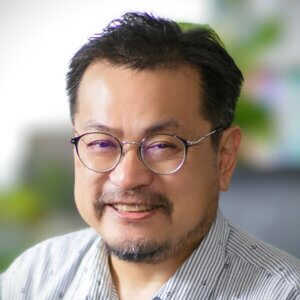濱野 真二郎 教授

専門・研究テーマ・キーワード
寄生虫学担当課程
博士前期課程専任教員取得学位・資格
MD, PhD
個人/所属ウェブページ
- http://www.tm.nagasaki-u.ac.jp/nekken/research/parasitology.html
- http://www.tm.nagasaki-u.ac.jp/lf-ntd/
ResearchGate/LinkedInアカウント
- https://www.researchgate.net/profile/Shinjiro_Hamano
- https://www.linkedin.com/hp/?dnr=SDR3GNVkTJO33zBQbaDMLWukbiN3_UtX0mB&trk=nav_responsive_tab_home
他所属
- Department of Parasitology, Institute of Tropical Medicine (NEKKEN) Nagasaki University, 1-12-4 Sakamoto, Nagasaki 852-8523, JAPAN
- Nagasaki University Nairobi Research Station, NUITM-KEMRI Project, Nairobi, Kenya
経歴
Shinjiro Hamano MD, PhD is a Professor of Institute of Tropical Medicine, Nagasaki University from 2009. Dr. Hamano graduated in medicine and received a MD degree from Kumamoto University in 1993 and a PhD degree from Kyushu University, Fukuoka in 1999. Then, he has been studying host defense mechanisms against various protozoan and helminthic parasites in Kyushu University and Nagasaki University. His research interests are on tropical infectious diseases and host defense mechanism to microbes including parasites. During 2004 to 2006, he had visited University of Virginia and dedicated his time to elucidate the determinants for Entamoeba histolytica to establish the infection using animal model. Dr. Hamano and his colleagues elucidated the pathogenicity of Entamoeba moshkovskii and the role of newly identified heterodimeric cytokine IL-27 and its receptor WSX-1 in host defense to protozoan parasites. He has also engaged in field study about tropical infectious diseases in developing countries.
教育活動
- Parasitic diseases are still a huge menace to human health and continue unabated in tropical areas under the conditions of poverty and the unique natural and social environments. Various kinds of parasites infect humans for long periods of time without killing them, giving rise to tremendous social and/or economic loss. We would like to help students develop deep insight into parasitic diseases and the surrounding factors from various points of view. The roles on TMGH courses is to show existing and new knowledge and to provide an enthusiastic environment for the future generation.
- Parasitology, Neglected Tropical Diseases, Immunology
現在の主な研究活動地域
- Kenya
- Bangladesh
最近の5つの出版物
- Kokubo-Tanaka M, Kildemoes AO, Chadeka EA, Cheruiyot BN, Moriyasu T, Sassa M, Nakamura R, Kikuchi M, Fujii Y, de Dood CJ, Corstjens PLAM, Kaneko S, Maruyama H, Njenga SM, de Vrueh R, Hokke CH, Hamano S. Detection and analysis of Serpin and RP26 specific antibodies for monitoring Schistosoma haematobium transmission. PLoS Negl Trop Dis. 2025; 19(1): e0012813.
- Ouji Y, Hamasaki M, Misu M , Yoshikawa M, Hamano S. Labeling of miracidium using fluorescent agents to visualize infection of schistosome in intermediate host snails. Parasitol Int. 2025; 104:102994.
- Sepahpour T, Alshaweesh J, Azodi N, Singh K, Ireland DDC, Valanezhad F, Nakamura R, Satoskar AR, Dey R, Hamano S, Nakhasi HL, Gannavaram S. Downregulation of IRF7-mediated type-I interferon response by LmCen-/- parasites is necessary for protective immunity. NPJ Vaccines. 2024; 9(1):250.
- Dey R, Alshaweesh J, Singh KP Lypaczewski P, Karmakar S, Klenow L, Paulini K, Kaviraj S, Kamhawi S, Valenzuela JG, Singh S, Hamano S, Satoskar AR, Gannavaram S, Nakhasi HL, Matlashewski G. Production of leishmanin skin test antigen from Leishmania donovani for future reintroduction in the field. Nat Commun. 2023; 14(1):7028.
- Alshaweesh J, Nakamura R, Tanaka Y, Hayashishita M, Musa A, Kikuchi M, Inaoka DK, Hamano S. Leishmania major strain-dependent macrophage activation contributes to pathogenicity in the absence of lymphocytes. Microbiol Spectr. 2022; 10(5): e0112622.
メッセージ
Parasitic diseases are still a huge menace to human health and continue unabated in tropical areas under the conditions of poverty and the unique natural and social environments. Various kinds of parasites infect humans for long periods of time without killing them, giving rise to tremendous social and/or economic loss. We would like to help students develop deep insight into parasitic diseases and the surrounding factors from various points of view. The roles on TMGH courses is to show existing and new knowledge and to provide an enthusiastic environment for the future generation.
